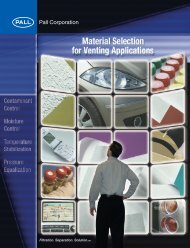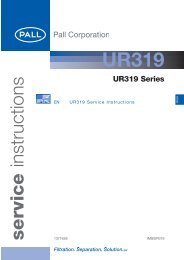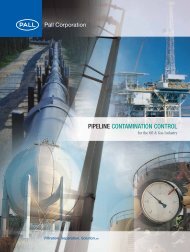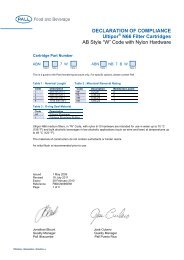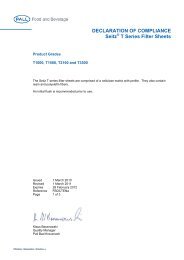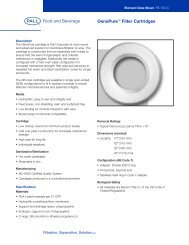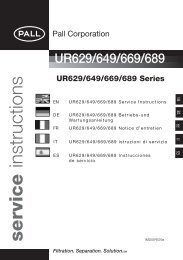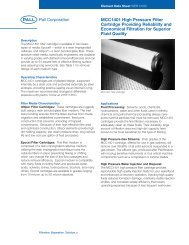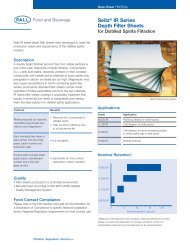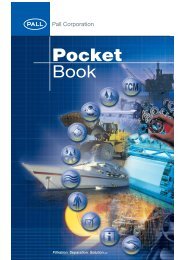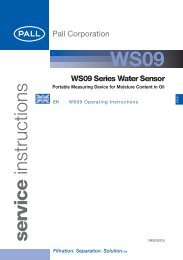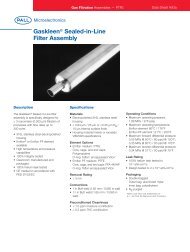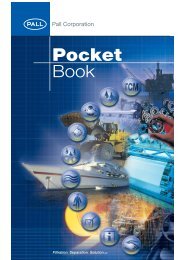Automated Plate ELISA and Dot-Blot Assays ... - Pall Corporation
Automated Plate ELISA and Dot-Blot Assays ... - Pall Corporation
Automated Plate ELISA and Dot-Blot Assays ... - Pall Corporation
Create successful ePaper yourself
Turn your PDF publications into a flip-book with our unique Google optimized e-Paper software.
Scientific & Technical Report PN 33293<strong>Automated</strong> <strong>Plate</strong> <strong>ELISA</strong> <strong>and</strong> <strong>Dot</strong>-<strong>Blot</strong> <strong>Assays</strong>Using AcroWell 96 Filter <strong>Plate</strong>s <strong>and</strong> a RoboticWorkstation with Integrated <strong>Plate</strong> ReaderBy Norina M. Tang, Ph.D. 1 <strong>and</strong> Lois Tack, Ph.D. 21<strong>Pall</strong> Life Sciences, 600 South Wagner Road, Ann Arbor, MI 48103, USA. Norina_tang@pall.com2PerkinElmer Life Sciences, 2200 Warrenville Road, Downers Grove, IL 60515, USA. Ltack@packardbioscience.comIntroductionThe near completion of the Human GenomeProject, <strong>and</strong> many other genetic sequencingprojects in recent years, have brought on theproteomics era. Scientists now have the greaterchallenge of identifying all of the resulting geneproducts <strong>and</strong> assigning functions to therespective proteins. One classical technique forprotein analysis is the western immunoblot that,although highly specific, is time-consuming,technically difficult, <strong>and</strong> not very sensitive.Moreover, the technique is low-throughput<strong>and</strong> difficult to automate. In response to thesevarious technical difficulties <strong>and</strong> limitationsassociated with the western immunoblot,<strong>Pall</strong> <strong>Corporation</strong> (East Hills, NY), a leader inmembrane filtration <strong>and</strong> product design,teamed up with PerkinElmer Life Sciences(Boston, MA, USA), an industry leader in thefield of automation <strong>and</strong> equipment, to developan alternative assay for the detection ofprotein-protein interactions. The alternativeassay that is described in this study uses96-well membrane-bottom plates to specificallyseparate <strong>and</strong> capture proteins of interest thatare then detected by a chemiluminescent orfluorescent reader.Historically, the filtration of samples in a 96-wellformat has exposed a variety of problemsincluding well-to-well variation, inability toempty all wells, stacking <strong>and</strong> h<strong>and</strong>ling issues,solution weeping, <strong>and</strong> high background levels.These issues impact automation affecting bothdata integrity <strong>and</strong> preventing h<strong>and</strong>s-free, walkawayprocedures. Most problems associatedwith plate filtration are due to the structure <strong>and</strong>quality of the multi-well filter plates as well as thevacuum manifold design. Through careful design<strong>and</strong> engineering, <strong>Pall</strong> <strong>Corporation</strong> has developedthe AcroWell 96 polypropylene filter platecontaining various high performance membranes.The membranes are sealed to the polypropylenehousing using a patented process thatdramatically reduces crosstalk <strong>and</strong> weeping.AcroWell 96 filter plates meet Society forBiomolecular Screening (SBS) recommendationsfor automated h<strong>and</strong>ling <strong>and</strong> are ideal for rapid<strong>and</strong> specific biomolecule detection using roboticsystems. AcroWell 96 filter plates are availablein various colors to help optimize detection.In this study, we demonstrate the use ofAcroWell 96 filter plates with BioTrace membranes for automated plate <strong>ELISA</strong> <strong>and</strong>dot-blot applications. We show data for thechemiluminescent <strong>and</strong> fluorescent detection ofspecific protein binding. We then show data forthe immunodetection of CDK2 in crude humanT-cell lysates. These assays were carried outboth manually <strong>and</strong> using a fully automatedmulti-instrument system from PerkinElmerLife Sciences consisting of a multi-mode platereader integrated with a liquid h<strong>and</strong>ling platform.The specific robotic workstation used consistedof the MultiPROBE* II HT EX workstation withGripper* Integration Platform, Vacuum FiltrationOption, <strong>and</strong> Fusion* Universal Microplate Analyzer.
Workstation <strong>and</strong> MaterialsThe assays in this study were performed using aMultiPROBE* II HT EX workstation with Gripper* IntegrationPlatform <strong>and</strong> Fusion* Universal Analyzer. The PackardVacuum Filtration Option was also included. 1, 2The vacuum filtration system with PVM manifold iscompatible with fully automated processing of <strong>Pall</strong>’sAcroWell 96 binding filter plates. In this study, vacuumfiltration was carried out at 10 to 12 in. Hg.<strong>Pall</strong>’s AcroWell 96 filter plates are available in clear, white, <strong>and</strong>black housing colors. Choose clear plates for time-resolvedfluorescence, 3 white plates for chemiluminescence/radioactivity, <strong>and</strong> black plates for fluorescein detectionassays. <strong>Plate</strong>s are also offered in a variety of high-performancemembrane options <strong>and</strong> device configurations.MultiPROBE II specialized labware was used to automatethe <strong>Pall</strong> AcroWell 96 filter plate assays for this study.Various colored AcroWell 96 Filter <strong>Plate</strong>sMultiPROBE II HardwarePackardPart Number DescriptionAMP8E02 MultiPROBE II HT EX/ComputerAMPGRE0 Gripper Integration Platform7401489 ACB100 (100/60)2004082 GAST Vacuum Pump (115/60)7800483/B VersaTip* Plus Software7601811 Vacuum Filtration Option6000656 200 mL Conductive Tips5078889 Tile, Troughs, MPII HT5079598 Trough Holder, 60 mL, 4 Pos.6008104 Troughs, 60 mLA153604 Fusion* HT Universal Analyzer7400139 Fusion: Blue PMT7009577 Fusion Integration Software7801539 Fusion Remote Control SoftwareAcroWell 96 Filter <strong>Plate</strong> Features• Polypropylene construction for low non-specific binding• High performance membranes (e.g., PVDF, nitrocellulose)• Automation-friendly• No crosstalk between wells• No weeping of solutions• Range of available housing colors• One-piece housing construction prevents jammingin instrumentsAcroWell 96 Filter <strong>Plate</strong>s<strong>Pall</strong> Part No. DescriptionPN 5027 AcroWell 96 Filter <strong>Plate</strong> with BioTrace PVDF Membrane, white, 10/pkgPN 5025 AcroWell 96 Filter <strong>Plate</strong> with BioTrace NTMembrane, black, 10/pkg
Results — ChemiluminescenceProtein Binding Capacity <strong>and</strong> Detection SensitivityThe first step in the dot-blotting procedure is the binding ofthe target protein to the membrane. For our first experiment,varying amounts (2.5-1000 pg) of HRP-labeled goat IgGwere added to prewetted white AcroWell 96 PVDF filterplates for 30 minutes <strong>and</strong> washed. LumiGLO* was addedfor 5 minutes. The plates were read automatically using theintegrated Fusion* reader (luminescence mode) or manuallyusing a PerkinElmer MICROBETA* Counter. 4The results indicate that as little as 2.5 pg of goat IgG canbe reliably detected using the AcroWell 96 filter plate systemas described. Moreover, the linear range of binding <strong>and</strong>detection is over 3 orders of magnitude.Figure 1MultiPROBE* II Deck Layout <strong>and</strong> <strong>Pall</strong> Protocol Outline<strong>Automated</strong>:Figure 2Protein Binding to BioTrace PVDF MembraneBound Protein, RLU (n=11)RLU8000070000R 2 = 0.999660000500004000030000200001000000 200Protein Binding to PVDF MembraneUsing <strong>Automated</strong> Protocol400 600 800 1000 1200Goat IgG-HRP (pg)6000050000R 2 = 0.9944000030000200001000000 10 20 30 40 50 60Goat IgG-HRP (pg)Protein Binding to PVDF MembraneUsing Manual Protocol140000WinPREP* software automated the assay shown below.Manual:Manual Protocol1. Prewet PVDF membrane2. Wash3. Bind HRP-Antibody4. Wash5. <strong>Blot</strong> off excess fluid6. Add LumiGLO7. ReadAvg LCPS (n=8)Avg LCPS (n=8)120000R 2 = 0.99381000008000060000400002000000 200400 600 800 1000 1200Goat IgG-HRP (pg)700006000050000R 2 = 0.99294000030000200001000000 10 20 30 40 50 60 70 80Goat IgG-HRP (pg)For ordering or technical information call your local.<strong>Pall</strong> Life Sciences office listed on the back page.www.pall.com/lab
Specific Protein BindingThe second experiment demonstrates the use of theAcroWell 96 filter plate for the immunodetection of anabundant, purified protein.Varying amounts (1-8 ng) of rabbit IgG (Kirkegaard & PerryLaboratories) were added to prewetted white AcroWell 96filter plates with BioTrace PVDF membrane for 30 minutes<strong>and</strong> washed. Following incubation with Block (30 minutes)<strong>and</strong> washing, HRP-labeled goat anti-rabbit IgG was addedfor 60 minutes <strong>and</strong> washed. Following LumiGLO* additionfor 5 minutes, the plates were read as before. 4Figure 3MultiPROBE* II Deck Layout <strong>and</strong> <strong>Pall</strong> Protocol Outline<strong>Automated</strong>:These data show that the signal measured from the secondaryantibody correlated directly to the amount of target proteinpresent. Under these experimental conditions, the specificbinding <strong>and</strong> detection of the target rabbit IgG proteins islinear from approximately 1 to 10 ng.Figure 4Specific Protein BindingAvg RLU (n=8)100000900008000070000R 2 = 0.9909Specific Protein BindingUsing <strong>Automated</strong> Protocol60000500000 2 4 6 8 10Rabbit IgG (ng)WinPREP* software automated the assay shown below.Manual:Manual Protocol1. Prewet PVDF membrane2. Wash3. Bind target proteins4. Wash5. Block6. Wash7. Bind HRP-Antibody8. Wash9. <strong>Blot</strong> plate10. Add LumiGLO11. ReadAvg LCPS (n=3)Specific Protein BindingUsing Manual Protocol120000R 2 = 0.976111000010000090000800007000060000500000 2 4 6 8 10Rabbit IgG (ng)
Detection of CDK2 from Jurkat CellsTo more rigorously test the sensitivity <strong>and</strong> dynamic range ofthe AcroWell 96 filter plate system, a third experiment wasperformed to specifically bind <strong>and</strong> detect cyclin-dependentkinase 2 (CDK2) in Jurkat cells. Varying amounts (1-5000 ng)of Jurkat cell lysate (BD Transduction Labs) were added toan AcroWell 96 PVDF filter plate for 30 minutes <strong>and</strong> washed.After blocking for 30 minutes <strong>and</strong> washing, anti-CDK2 mAb(BD Transduction Labs) was added for 60 minutes <strong>and</strong>washed. HRP-labeled goat anti-mouse IgG was added for60 minutes <strong>and</strong> washed. LumiGLO* was added <strong>and</strong> plateswere read after 5 minutes as before. 4Figure 5MultiPROBE* II Deck Layout <strong>and</strong> <strong>Pall</strong> Protocol OutlineThese data show that using the AcroWell 96 filter platesystem, CDK2 protein kinase from crude cell lysates canbe specifically detected linearly over one order of magnitude.The exact range of detection will vary depending onexperimental conditions.Figure 6Detection of CDK2 from Jurkat Cells1000095009000Detection of CDK2 from Jurkat CellsUsing <strong>Automated</strong> Protocol<strong>Automated</strong>:RLU (n=8)8500800075007000650060001 10 100 1000Jurkat Cell Lysate (ng)50000Detection of CDK2 from Jurkat CellsUsing Manual ProtocolWinPREP* software automated the assay shown below.Manual:Manual Protocol1. Prewet PVDFmembrane2. Wash3. Bind cell lysate4. Wash5. Block6. Bind primaryAntibody7. Wash8. Bind HRP-Antibody9. Wash10. <strong>Blot</strong> excess fluid11. Add LumiGLO12. ReadLCPS (n=2)45000400003500030000250001 10 100 1000 10000Jurkat Cell Lysate (ng)For ordering or technical information call your local.<strong>Pall</strong> Life Sciences office listed on the back page.www.pall.com/lab
Filter <strong>Plate</strong> Compared to WesternImmunoblot TechniqueThe results presented above in Figure 6 were comparedto results obtained from traditional western immunoblottechniques for the detection of CDK2 from Jurkat cells.Indicated amounts of Jurkat cell lysate were eletrophoresed<strong>and</strong> electroblotted to a BioTrace PVDF membrane.Following blocking <strong>and</strong> washing, the membrane blot wasincubated with anti-CDK2 mAb (60 minutes), washed <strong>and</strong>incubated with HRP-goat anti-mouse IgG (60 minutes). Afterwashing, the blot was treated with LumiGLO* (5 minutes)<strong>and</strong> exposed to X-ray film for indicated times.Compared to the AcroWell 96 filter plate technique, thewestern immunoblot technique was 10- to 100-fold lesssensitive (using identical reagents) in detecting CDK2 kinasefrom Jurkat cell lysate. In addition, the AcroWell 96 filter platetechnique required only 3.5 to 4.5 hours to complete whilethe western immunoblot technique required 8 or more hours.Results — FluorescenceProtein Binding Capacity <strong>and</strong> Detection SensitivityAcroWell filter plates can also be used for fluorescencedetection. Similar to the chemiluminescent results of Figure 2,the results below show that nanogram or sub-nanogramamounts of protein can be detected. In addition, the linearbinding <strong>and</strong> detection range is over 3 orders of magnitude.Varying amounts (0.5-500 ng) of fluorescein-labeled rabbitanti-goat IgG (Kirkegaard & Perry Laboratories) were addedto a white AcroWell 96 filter plate with BioTrace NTmembrane for 5 minutes, washed <strong>and</strong> blotted. <strong>Plate</strong>swere automatically read using the integrated Fusion*reader (top read fluorescence mode).Figure 8MultiPROBE* II Deck Layout for a Fluorescent-labeledProtein Binding ProtocolFigure 7Protein Electro-blotting Technique for theChemiluminescent Detection of CDK2 from Jurkat CellsA. Short exposure (20 seconds)kDa202133714231MW 0.5 1.0 2.5 5.0 .5 10 15µg of Cell LysateB. Long exposure (20 minutes)kDa202133714231MW 0.5 1.0 2.5 5.0 .5 10 15µg of Cell LysateFigure 9<strong>Automated</strong> Fluorescent Protein Binding140000<strong>Automated</strong> F-RAG IgG Binding Assay120000Avg RFU (n=8)1000008000060000400002000000 100 200 300 400 500 600Added Protein (ng)
Specific Protein BindingVarying amounts (0.25-50 ng) of goat IgG were added to ablack AcroWell 96 filter plate with BioTrace NT membranefor 30 minutes <strong>and</strong> washed. Block (BSA, Kirkegaard & PerryLaboratories) was added for 5 minutes <strong>and</strong> washed.Fluorescein-labeled rabbit anti-goat IgG was added for 60minutes <strong>and</strong> washed. <strong>Plate</strong>s were read using the VICTOR*1420 Multilabel Counter.The data below demonstrate that the antibody:antigeninteraction detected by fluorescence is highly specific <strong>and</strong>sensitive. As anticipated, the linear range is 10-fold <strong>and</strong>, inthis particular case, from 3 to 50 ng of antigen.Figure 10Manual Fluorescent Specific Protein BindingFluorescein CPSManual Protocol1. Bind proteins toNT membrane2. Wash3. Block4. Wash4000035000300002500020000150001000050000Specific Protein Detection UsingFluorescent-labeled Antibody0 0.25 0.5 1 2 3 6 12.5 25 50Goat IgG (ng)5. Bind fluorescein-Antibody6. Wash7. <strong>Blot</strong> excess fluid8. ReadConclusions<strong>Pall</strong> AcroWell 96 Filter <strong>Plate</strong>s• The use of the AcroWell 96 membrane-bottom filter plateis an attractive alternative to western immunoblot becauseof its simplicity, rapidity, automation capability, <strong>and</strong>increased sensitivity.• Compared to classical western immunoblot, the AcroWell 96filter plate technique can be up to 100-fold more sensitive.• AcroWell 96 filter plate assay takes approximately half thetime or less to complete compared to westernimmunoblot assay.• AcroWell 96 filter plate’s polypropylene housing <strong>and</strong> lowhold-up configuration using SBS robotic guidelines resultin low non-specific binding, consistent CV’s, greaterdetection accuracy, <strong>and</strong> automated processing.• The variety of plate housings available for AcroWell 96 filterplates allows optimized detection by chemiluminescent,radiometric, <strong>and</strong> fluorescent techniques.• The use of high-performance binding membranes such asBioTrace PVDF <strong>and</strong> NT, permits strong, reproducible bindingresulting in improved specific detection of biomolecules.MultiPROBE* II Analysis Workstation• Workstation features fully automated pipetting gripper tomove plate, <strong>and</strong> vacuum, timer control, plate read, <strong>and</strong>data file storage functions.• Custom software integration package provides interfacebetween WinPREP* script functions <strong>and</strong> Fusion*instrument control software.• Multi-instrument platform carries out complex protocolsthat include assay set up <strong>and</strong> selection of desired FusionAssay Definition (e.g., luminescence or fluorescence).• Gripper* Integration Platform provides large off-deck workarea ideal for integrating multi-mode plate readers such asFusion without losing valuable deck space.• WinPREP software supports multipart protocols (e.g., CDK2detection assay protocol contains 17 separate pipettedispense <strong>and</strong> 17 vacuum steps). Software allows dispensingLumiGLO* substrate in same order as plate read format tominimize time sensitivity of luminescence assays.• Gripper with theta rotational function correctly positionsassay plates in the plate reader carrier.• Precision control of time-sensitive assays using WinPREPtime marker <strong>and</strong> Fusion software functions fully automatepipetting gripper move plate, vacuum, timer control, plateread, <strong>and</strong> data file storage functions.For ordering or technical information call your local.<strong>Pall</strong> Life Sciences office listed on the back page.www.pall.com/lab
References1. Tack, L.C., Holly, D., Galdar, L., <strong>and</strong> Staat, S. 2001.“<strong>Automated</strong> Protein <strong>and</strong> Nucleic Acid Analysis Using aRobotic Liquid H<strong>and</strong>ling Workstation <strong>and</strong> Multi-Mode<strong>Plate</strong> Reader.” PerkinElmer Liquid H<strong>and</strong>ling ApplicationNote LHA-022.2. Tack, L.C., Van Dinther, J., <strong>and</strong> Ahrweiler, P. 2001.“Fully <strong>Automated</strong> Nucleic Acid Extraction Using theMultiPROBE* II HT EX with Gripper Integration Platform<strong>and</strong> PVM Vacuum Filtration System.” PerkinElmer LiquidH<strong>and</strong>ling Application Note LHA-017.3. Valenzano, K.J., W. Miller, J. Kravitz, P. Samama, D.Fitzpatrick <strong>and</strong> K. Seeley. 2000. “Development of aFluorescent Lig<strong>and</strong>-Binding Assay Using the AcroWellFilter <strong>Plate</strong>.” J. Biomolecular Screening 5(6):455-461.4. Tang, N.M. 2001. “Chemiluminescent Detection forSpecific Protein Binding Using the AcroWell 96 Filter<strong>Plate</strong> with BioTrace PVDF Membrane.” <strong>Pall</strong> Life SciencesScientific <strong>and</strong> Technical Report, PN 33234.Additional Literature1. Seeley, K. 2000. “Biomolecule Binding <strong>and</strong> BlockingProcedures for AcroWell Filter <strong>Plate</strong>s with BioTrace NT<strong>and</strong> BioTrace PVDF Membranes.” <strong>Pall</strong> Life SciencesScientific <strong>and</strong> Technical Report, PN 33189.2. Tang, N., Wilson, D., Seeley, K. 2002. “<strong>Automated</strong>Purification of Combinational Libraries Using AcroPrep 96Filter <strong>Plate</strong> with GHP Membrane.” <strong>Pall</strong> Life SciencesScientific <strong>and</strong> Technical Report, PN 33245.3. Seeley, K., Niemiec, K. 2000. “The AcroWell Filter <strong>Plate</strong>Minimizes Crosstalk.” <strong>Pall</strong> Life Sciences Scientific <strong>and</strong>Technical Report, PN 33177.4. “AcroWell 96 Membrane-bottom Filter <strong>Plate</strong>s.” <strong>Pall</strong> LifeSciences Product Data, PN 33296.<strong>Pall</strong> LIfe Sciences600 South Wagner RoadAnn Arbor, MI 48103-9019 USA800.521.1520 toll free in USA734.665.0651 phone734.913.6114 faxAustralia – Lane Cove, NSWTel: 02 9428-23331800 635-082 (in Australia)Fax: 02 9428-5610Austria – WienTel: 043-1-49 192-0Fax: 0043-1-49 192-400Canada – OntarioTel: 905-542-0330800-263-5910 (in Canada)Fax: 905-542-0331Canada – QuébecTel: 514-332-7255800-435-6268 (in Canada)Fax: 514-332-0996800-808-6268 (in Canada)China – P. R., BeijingTel: 86-10-8458 4010Fax: 86-10-8458 4001France – St. Germain-en-LayeTel: 01 30 61 39 92Fax: 01 30 61 58 01Lab-FR@pall.comGermany – DreieichTel: 06103-307 333Fax: 06103-307 399Lab-DE@pall.comIndia – MumbaiTel: 91-22-5956050Fax: 91-22-5956051Italy – MilanoTel: 02-47796-1Fax: 02-47796-394or 02-41-22-985Japan – TokyoTel: 3-3495-8319Fax: 3-3495-5397Korea – SeoulTel: 2-569-9161Fax: 2-569-9092Pol<strong>and</strong> – WarszawaTel/Fax: 22-835 83 83Russia – MoscowTel: 095 787-76-14Fax: 095 787-76-15SingaporeTel: (65) 389-6500Fax: (65) 389-6501Spain – MadridTel: 91-657-9876Fax: 91-657-9836Sweden – LundTel: +46 (0)46 158400Fax: +46 (0)46 320781Switzerl<strong>and</strong> – BaselTel: 061-638 39 00Fax: 061-638 39 40Taiwan – TaipeiTel: 2-2545-5991Fax: 2-2545-5990United Kingdom –PortsmouthTel: 023 92 302600Fax: 023 92 302601Lab-UK@pall.comVisit us on the Web at www.pall.com/labE-mail us at Lab@pall.com©2003 <strong>Pall</strong> <strong>Corporation</strong>. <strong>Pall</strong>, , AcroWell, <strong>and</strong> BioTrace are trademarks of <strong>Pall</strong> <strong>Corporation</strong>. The ®indicates a trademark registered in the USA.is a service mark of <strong>Pall</strong> <strong>Corporation</strong>.*Packard MultiPROBE II, MICROBETA, <strong>and</strong> WinPREP are registered trademarks, <strong>and</strong> Fusion, Gripper,VersaTip, <strong>and</strong> VICTOR are trademarks of PerkinElmer, Inc. LumiGLO is a registered trademark of Kirkegaard &Perry Laboratories, Inc.02/03, 2.5k, GN02.0624 PN 33293



